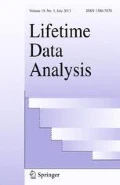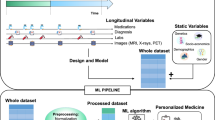Abstract
Receiver operating characteristic (ROC) curves play a central role in the evaluation of biomarkers and tests for disease diagnosis. Predictors for event time outcomes can also be evaluated with ROC curves, but the time lag between marker measurement and event time must be acknowledged. We discuss different definitions of time-dependent ROC curves in the context of real applications. Several approaches have been proposed for estimation. We contrast retrospective versus prospective methods in regards to assumptions and flexibility, including their capacities to incorporate censored data, competing risks and different sampling schemes. Applications to two datasets are presented.
Similar content being viewed by others
References
Antolini L, Boracchi P and Biganzoli E (2005). A time dependent discrimination index for survival data. Stat Med 24: 3927–3944
Baker SG (2003). The central role of receiver operating characteristic (ROC) curves in evaluating tests for the early detection of cancer. J Natl Cancer Inst 95: 511–515
Begg CB and Greenes RA (1983). Assessment of diagnostic tests when disease verification is subject to selection bias. Biometrics 39: 207–215
Cai T, Pepe MS, Zheng Y, Lumley T and Jenny NS (2006). The sensitivity and specificity of markers for event times. Biostatistics 7: 182–197
Cai T and Pepe MS (2002). Semi-parametric ROC analysis to evaluate biomarkers for disease. J Am Stat Assoc 97: 1099–1107
Chambless LE and Diao G (2006). Estimation of time-dependent area under the ROC curve for long-term risk prediction. Stat Med 25: 3474–3486
Cohn JN and Tognoni G (2001). A randomized trial of the angiotensin-receptor blocker valsartan in chronic heart failure. N Engl J Med 345: 1667–1675
Cook NR (2007). Use and misuse of the receiver operating characteristic curve in risk prediction. Circulation 115: 928–935
Delong ER, Vernon WB and Bollinger RR (1985). Sensitivity and specificity of a monitoring test. Biometrics 41: 947–958
Emir B, Wieand S, Su JQ and Cha S (1998). Analysis of repeated markers used to predict progression of cancer. Stat Med 17: 2563–2578
Etzioni R, Pepe M, Longton G, Hu C and Goodman G (1999). Incorporating the time dimension in receiver operating characteristic curves: a case study of prostate cancer. Med Decis Making 19: 242–251
Heagerty PJ and Zheng Y (2005). Survival model predictive accuracy and ROC curves. Biometrics 61: 92–105
Heagerty PJ, Lumley T and Pepe MS (2000). Time-dependent ROC curves for censored survival data and a diagnostic marker. Biometrics 56: 337–344
Kalbfleisch JD and Prentice RL (1980). The statistical analysis of failure time data. Wiley, New York
Koenker R and Bassett G (1978). Regression quantiles. Econometrica 46: 33–50
Leisenring W, Pepe MS and Longton G (1997). A marginal regression modelling framework for evaluating medical diagnostic tests. Stat Med 16: 1263–1281
Levy WC, Mozaffarian D, Linker DT, Sutradhar SC, Anker SD, Cropp AB, Anand I, Maggioni A, Burton P, Sullivan MD, Pitt B, Poole-Wilson PA, Mann DL and Packer M (2006). The Seattle Heart Failure model: prediction of survival in heart failure. Circulation 113: 1424–1433
McIntosh M and Pepe MS (2002). Combining several screening tests: optimality of the risk score. Biometrics 58: 657–664
Packer M, O’Connor CM, Ghali JK, Pressler ML, Carson PE, Belkin RN, Miller AB, Neuberg GW, Frid D, Wertheimer JH, Cropp AB, DeMets DL and for the Prospective Randomized Amlodipine Survival Evaluation Study Group (1996). Effect of amlodipine on morbidity and mortality in severe chronic heart failure. New Eng J Med 335: 1107–1114
Parker CB and Delong ER (2003). ROC methodology within a monitoring framework. Stat Med 22: 3473–3488
Pepe MS (2003). The statistical evaluation of medical tests for classification and prediction. Oxford University Press, New York
Song X, Zhou XH (in press) A semiparametric approach for the covariate specific ROC curve with survival outcome. Stat Sinca.
Wang TJ, Gona P, Larson MG, Tofler GH, Levy D, Newton-Cheh C, Jacques PF, Rifai N, Selhub J, Robins SJ, Benjamin EJ, D’Agostino RB and Vasan RS (2006). Multiple biomarkers for the prediction of first major cardiovascular events and death. N Engl J Med 355: 2631–2639
Wieand S, Gail MH, James BR and James KL (1989). A family of nonparametric statistics for comparing diagnostic markers with paired or unpaired data. Biometrika 76: 585–592
Xu R and O’Quigley J (2000). Proportional hazards estimate of the conditional survival function. J Roy Stat Soc Ser B 62: 667–680
Zheng Y and Heagerty PJ (2004). Semiparametric estimation of time-dependent ROC curves for longitudinal marker data. Biostatistics 5: 615–632
Zheng Y and Heagerty PJ (2007). Prospective accuracy for longitudinal markers. Biometrics 63: 332–341
Zheng Y, Cai T and Feng Z (2006). Application of the time-dependent ROC curves for prognostic accuracy with multiple biomarkers. Biometrics 62: 279–287
Author information
Authors and Affiliations
Corresponding author
Rights and permissions
About this article
Cite this article
Pepe, M., Zheng, Y., Jin, Y. et al. Evaluating the ROC performance of markers for future events. Lifetime Data Anal 14, 86–113 (2008). https://doi.org/10.1007/s10985-007-9073-x
Received:
Accepted:
Published:
Issue Date:
DOI: https://doi.org/10.1007/s10985-007-9073-x




